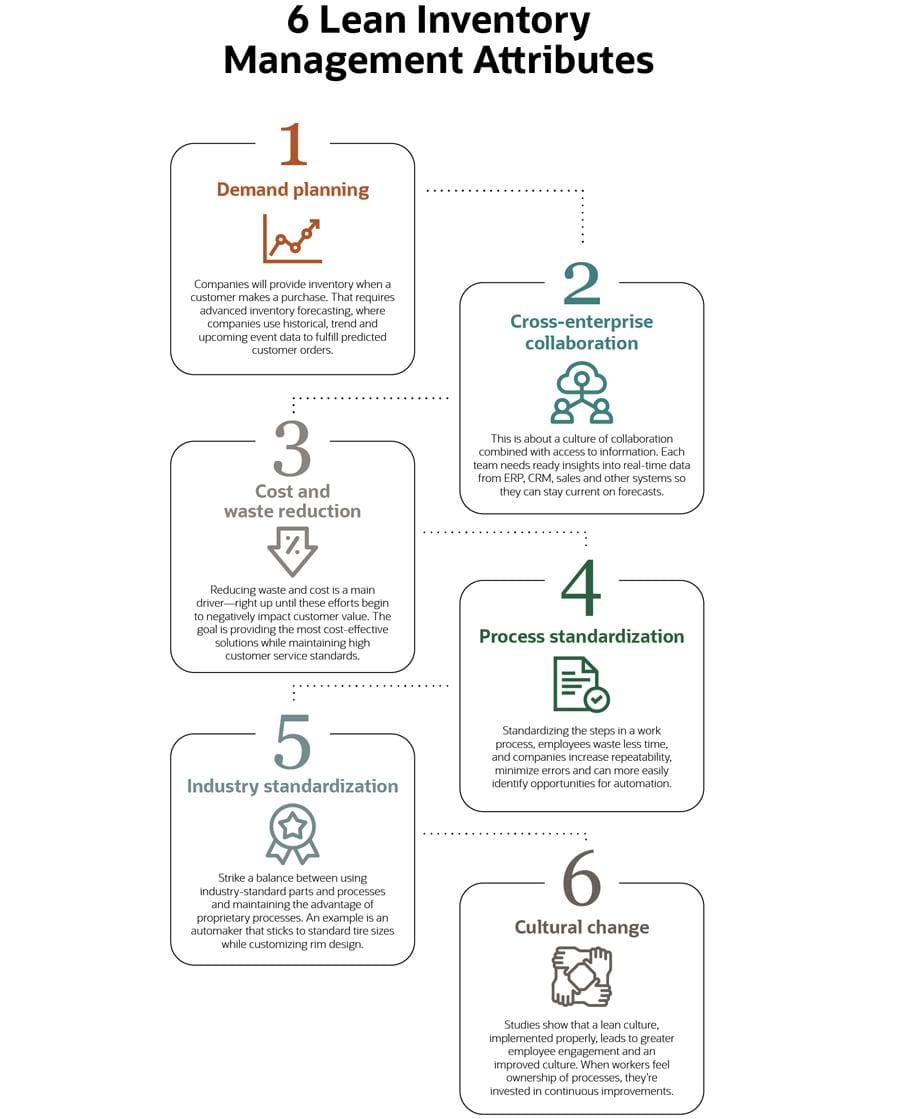Lean inventory management is all about refining how a company handles its supply chain and manufacturing processes, and it’s not just for companies looking to conserve capital or navigate uncertain markets. A lean inventory approach leverages continuous improvement methods to reduce waste — of time, materials and work. That improves efficiency, saves money and ultimately enables companies to provide more value to customers.
Finance teams understand that once purchased, inventory does not gain value until it is sold to the customer. Inventory is a cost that increases the longer stock is stored — carrying costs may add up to 30% per year. So a $10 part that sits on a shelf for six months could actually cost the company $11.50. That’s $1.50 added to the expected cost of goods sold.
Therefore, CFOs are generally proponents of lean inventory management, even after the challenges presented by global disruptions. Now it’s time to get everyone else on board.
What Is Lean Inventory Management?
Lean inventory management is an inventory planning approach that focuses on continually eliminating waste and inefficiency. Improvements might include fixing production bottlenecks that result in storage costs for work-in-progress inventory or training employees to follow a strict first in, first out process to minimize spoilage of perishable items.
A company that excels at lean inventory holds only what it needs at all stages of production and wastes minimal time, materials and effort. Businesses looking to get better at lean inventory management may benefit from improvement methodologies such as Kaizen, Kanban and Six Sigma. For example, Kanban is core to lean just-in-time (JIT) inventory and production management and helps eliminate waste due to overproduction because companies produce goods only once orders are in hand.
5 Key Principles of Lean Inventory Management
Together, five key principles work together to help companies meet the main goal of lean inventory management: increased efficiency.
The basis of these principles come from a 1996 book by James Womack and Dan Jones, founders of the Lean Enterprise Institute and the U.K. Lean Enterprise Academy. In Lean Thinking: Banish Waste and Create Wealth in Your Corporation, the authors laid out the main principles of lean manufacturing.
For the purposes of lean inventory, Womack’s and Jones’ concept of the “value stream” is often expressed as “responsiveness.” The value stream looks at the entire product lifecycle, from raw material to eventual disposal. Responsiveness is a narrower concept, concerned with staying nimble enough to pivot inventory to meet changes in demand or supply.
- Value: Under the five Lean principles, value refers to what customers want and will pay for. From an inventory perspective, businesses need to factor in customer demand when determining how much and what inventory to stock. Determining this is a function of demand planning, a cross-functional process that helps companies give customers what they want — thus minimizing excess inventory and dead stock.
- Flow: To apply lean inventory practices, companies must understand how inventory flows within the organization. A solid materials requirements planning (MRP) practice asks three questions, with responses dictating flow: What is needed? How much is needed? When is it needed by? The answers need to drive production schedules.
- Pull: A pull-based system is intrinsic to JIT inventory management, where products are created only when, and in the quantities, required. Pull follows naturally from the flow process and contrasts with a more demand-centric push-based system, which relies heavily on historical sales data to determine production levels.
- Responsiveness: The flexibility to adapt to change helps head off increased carrying costs and out-of-stock situations. Inventory management best practices including ABC analysis, demand forecasting and Economic Order Quantity (EOQ) aid responsiveness.
- Perfection: Striving for perfection encapsulates the lean philosophy — whether we’re talking manufacturing, inventory management or any other process. Continuous improvements to improve quality and eliminate waste and inefficiency move companies closer to the ideal.
7 Types of Waste in Lean Inventory Management
Inventory waste can be leftover materials from manufacturing, but also idle time spent waiting for needed stock, excess space and even the capital used to purchase goods without immediate returns.
Here are seven types of waste that can impact companies:
- Overproduction: Overproduction happens when products or parts that are not needed — or aren’t yet needed — are produced. Excess inventory can dramatically increase storage costs; worst case, you end up with dead stock that must be disposed of. Overages can happen in any of the four types of inventory: raw materials/components, work in progress, finished goods and MRO (maintenance, repair and operations) goods.
- Waiting: There is usually a lag time between manufacturing and sales phases. In lean inventory management, the goal is to minimize the time inventory sits idle. The longer inventory sits, the more it ties up a company's capital since no value is produced. Minimizing the time between phases involves overcoming a combination of inventory management challenges, including inconsistent tracking, manual documentation and poor production planning.
- Transporting: Transport waste happens when a product ends up being touched or moved unnecessarily, adding costs and increasing the risk of damage. Ideally, when an item arrives at the warehouse or storage area, it shouldn’t be moved again unless it’s to add value, like processing it for shipping to customers.
- Processing: Examples of excess processing include when a company adds superfluous packaging, or when a department must enter the same data in more than one place, either on paper forms or in multiple applications.
- Inventory: Excess inventory ties up both capital and storage space. It can also mask other kinds of waste, like purchasing too much or the wrong raw materials or producing defective parts or products, increasing the costs of rework.
- Motion: Motion is wasted when a person must search for items that are not where they should be, or when machinery must be frequently adjusted to accommodate inefficient processes. Wasted motion increases wear and tear on equipment, decreasing lifespan. With employees, it can increase the chances of accidents and injuries.
- Defects: When there are flaws in finished goods or raw materials, before or after production, that’s considered defect waste. It increases costs because items need to be reworked or completely replaced and results in delays, safety issues and increased data entry.
5S Framework
The 5S framework stands for “sort, straighten, shine, standardize and sustain.” It’s a systematic approach to organizing a workplace to increase the efficiency of daily operations by taking actions to eliminate waste that leads to errors, defects and injuries.
The five steps are fairly self-explanatory:
- Sort: This step entails sorting through all the items in work areas. Employees separate what’s needed and discard what’s not. This could be executed as part of normal cycle-counting efforts, where employees count small, preselected sections of inventory on a regular basis.
- Straighten: This entails configuring and organizing work areas so that employees can quickly locate what they need and execute tasks with a minimum of effort and movement.
- Shine: Work areas should be kept clean so that potential safety hazards or challenges that could disrupt production are easily spotted. Cleanliness also minimizes wasted motion, as when a worker must search for tools or materials.
- Standardize: Work processes and procedures should be standardized to eliminate confusion about how tasks or steps in the manufacturing process should be performed.
- Sustain: Sustaining continuous improvements means regularly revisiting all the previous steps, but it goes beyond that. By now, employees should be keeping their work areas clean and organized without being asked to do so by supervisors. Companies may set up formal audits to make sure all employees and departments are committed to lean inventory principles.
Lean Inventory Management Attributes
There are six main attributes involved in creating and maintaining a lean management system:
- Demand planning: Companies will provide inventory when a customer makes a purchase. That requires advanced inventory forecasting, where companies use historical, trend and upcoming event data to ensure they have just enough product to fulfill predicted customer orders.
- Cross-enterprise collaboration: This is about a culture of collaboration combined with access to information. Each team needs ready insights into real-time data from ERP, CRM, sales and other systems so they can stay current on forecasts.
- Cost and waste reduction: Reducing waste and cost is a main driver — right up until these efforts begin to negatively impact customer value. The goal is providing the most cost-effective solutions while maintaining high customer service standards.
- Process standardization: When companies optimize and then standardize the steps in a work process, employees waste less time, and companies increase repeatability, minimize errors and can more easily identify opportunities for automation. A defined work procedure is more likely to be consistently adhered to and, as a bonus, makes training easier.
- Industry standardization: Standardizing internal workflows gets you only so far. Companies need to strike a balance between using industry-standard parts and processes and maintaining the advantage of proprietary processes. An example is an automaker that sticks to standard tire sizes while customizing rim design.
- Cultural change: Studies show that a lean culture, implemented properly, leads to greater employee engagement and an improved culture. When workers feel ownership of processes, they’re invested in continuous improvements.

5 Ways To Build a Culture That Promotes Lean Inventory
- Distribute Authority
When employees have a match between responsibility and sphere of control, know that their insights are valued and executed on and see upward mobility within the company, they’re incentivized to contribute to continuous improvement efforts. - Rethink Partnerships
Especially in demand-sensitive businesses, craft supplier agreements that bring a creative approach to planning cycles, lead time commitments and inventory ownership. Collaborative policies with trading partners have a huge impact on inventory management success. - Embrace Metrics
You can’t manage what you can’t — or can’t bother to — measure. Companies with data-driven versus “feeling-based” management are able to scale, and stay lean while they do it. There is a straight line between information cycle time and tight control of inventory. - Bring the Customer Voice
The goal of lean inventory management is to give customers the right product, just in time and without defects. Companies that treat their customers as collaborators, continually engaging to gather ideas for improvements, gain both invaluable insights and more loyal clients. - Put the Vision In Writing
Develop a mission statement for the company, write it down and break it into strategic objectives. For example: “We will provide the best quality product for the lowest cost. We will put safety first. We will achieve an 85% customer retention rate.” Consider using the OSGM model, a process planning tool that templatizes objectives, goals, strategies and measures.
Benefits of Lean Inventory Management
So far, we’ve outlined how lean management works to improve efficiency, reduce waste and increase profitability using various principles and attributes.
Here’s how lean translates into benefits for your company:
Maximized profits:
A lean inventory effort can lower holding costs and minimize losses caused by obsolescence, spoilage and dead stock while also minimizing reduce out-of-stocks, which can alienate customers and cost future sales.
Waste reduction:
Because inventory is moved only in response to customer orders, you eliminate excess motion of people, machinery and materials and minimize the risk of damage and injury.
Increased product quality:
Decreasing the number of defects or reworks means better quality, lower rework and return costs and greater customer satisfaction.
Shorter lead times:
Shortening the time it takes from producing products to getting shipments in customers’ hands likewise increases satisfaction. You can also adapt more quickly to demand fluctuations.
Stock turnover:
Fast inventory turnover frees up warehouse space, reduces carrying costs and decreases the risk of obsolescence and spoilage.
Eco-friendly and sustainable business practices:
Adopting sustainable practices reduces your carbon footprint and makes a good impression with consumers who want eco-friendly products. As an example, you might use lean principles to go paperless, eliminating pick tickets, packing slips and other forms.
Boosts employee morale:
Because all employees and teams will have clearly defined roles and a better understanding of how they bring value to the company, adopting lean principles can shift your work culture to one that values continuous improvement.
Limitations of Lean Inventory Management
While there are plenty of benefits to lean inventory management, there are a few drawbacks beyond sluggish response to supply chain disruptions, including:
It’s time- and resource-intensive:
Establishing an effective lean management system means spending time and money on, for example, training programs and more current technology.
Lack of customization:
Because lean management is based on standardizing processes, it may not allow a lot of room to incorporate product customization or variation. Businesses that require a high level of personalization will benefit less from lean inventory management practices.
Team onboarding:
Employee buy-in can be a challenge, and because everyone in the company needs to be on board with lean practices, executive leadership, HR and managers must be committed to a cultural shift.
How to Implement Lean Inventory Management in Business
Ensuring all business units are committed to following the principles of lean inventory management is the first hurdle. Once you get buy-in from employees:
Build relationships with suppliers:
Maintaining solid relationships with those you rely on to provide materials can be at odds with a JIT philosophy that stresses tightly aligning supply with demand and keeping bare-minimum stock levels. Companies need to take a creative approach, focused on maintaining long-term and mutually valuable relationships. Communication and responsiveness are cheap but critical.
Use inventory management software:
Modern inventory management software solutions help your business stay on top of inventory by providing real-time stock level data. Inventory management systems can automate processes, such as synchronizing and monitoring stock movement throughout the supply chain, to provide regular updates.
History of Lean Inventory Management
The practice of lean inventory management is derived from the well-known Toyota Production System, which drew inspiration from predecessors, including Henry Ford and Eli Whitney, who pioneered the concept of interchangeable parts. The idea is to eliminate waste from the manufacturing process so that it increases the value of products.
Taichii Onho and Shigeo Shingo at Toyota famously incorporated techniques such as the Ford production methods, now called the Just in Time or Toyota Production System. The two continually analyzed production lines to help Toyota survive the post-war Japanese economic depression. A more current iteration of lean management originates from James Womack’s book, The Machine That Changed the World.
Lean Inventory Management Best Practices
To ensure your company can successfully implement lean inventory management principles, consider the following best practices:
- Maintain accurate inventory counts: This is very doable with the right inventory management system(opens in new tab), and as a bonus, you’ll minimize stockouts, which may translate into losses of about 4% of overall sales for a typical retailer.
- Implement cycle counting: Counting your inventory regularly ensures that numbers match up with purchase orders, so there is less waste driven by carrying excess stock. It also helps you identify instances of loss or theft.
- Partnerships with suppliers: Maintaining flexible relationships with key suppliers is vital to ensuring daily operations aren’t interrupted. A strong supply chain management practice helps by encouraging companies to treat processes, like planning, manufacturing and delivery, as interconnected business functions.
- Keep safety stock: Having the right amount of safety or buffer stock ensures you won’t have to pay extra for rush orders or tell customers that products are backordered. A typical a safety stock calculation might look like this:
How to Decide if Lean Inventory Management Is the Right Choice
Lean inventory management works for many business types, but there is no guarantee it will work for every company. This method is best suited for firms that mass produce products at scale and want to maintain high product quality, as well as companies that make products to order. It’s also ideal for businesses that don’t require a significant amount of customization or variation to their products or services.
Businesses with the budget to invest in training and purchasing enabling technology will also benefit more than those more dependent on paper and spreadsheets.
Implement Lean Inventory Management With NetSuite
Going all-in on lean inventory management is a challenging and iterative process, so make sure you have the right tools. Robust software like NetSuite Inventory Management is built to help businesses achieve lean inventory workflows and remain competitive in their industries. Features such as real-time reporting, sales cycle tracking and the ability to monitor safety stock will come in handy.
Henry Ford said, “Quality means doing it right when no one is looking.” When companies get full buy-in from leadership and employees, lean techniques allow them to become more efficient and proactive, improve their business processes and boost customer satisfaction. Even if your company can’t become as lean as Toyota, you can still implement some of key principles to reduce waste and strive to improve continuously.









